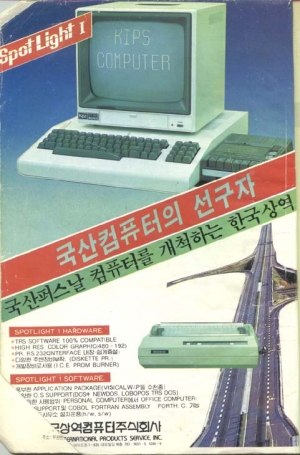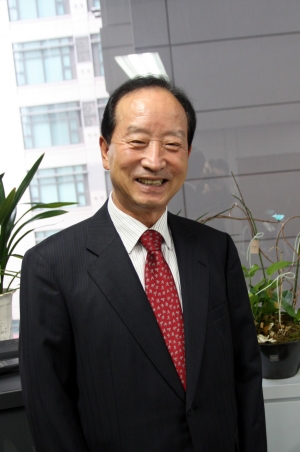The Personal Computer Arrives – A Story of the Early 1980s
The sixth installment in a twelve-part series - Ed.
PC as Zeitgeist
A personal computer, a general term for what we know today as a desktop computer, a laptop or a palmtop, revolutionized IT and communication processes by decentralizing computing power and thus encouraging individual creativity. Two technical innovations, the integrated circuit and the microprocessor, made the PC possible. They were developed in 1959 and 1971 respectively. The first such desktop-size system designed for personal use appeared in 1974 following these two technical innovations.
It, was in 1967 however that the electronic computer was introduced for the first time in Korea, when the Census and Statistics Bureau of the Economic Planning Board of the time purchased one and began to use it. The early 1980s saw the advent of the computer era in Korea, considering that the country's first PC (SE 8001) was developed by Sambo Engineering (predecessor of TriGem Computer) in 1981, only a year after IBM developed the PC. And the first-ever Hangul word processing program was developed in 1981. The following year, more than 3 million PCs were sold throughout the country. Finally, the government designated 1983 as the Year of Information Industry, and thus sent 5,000 PCs to nationwide schools for education.

Shin Kook-hwan
Korea is rated today as the leader in major sectors of the global IT industry, including semiconductor memory chips, LCD and OLED displays, despite the short history of its electronics industry. The country achieved its prominent status as a result of its top-notch electronics firms' efforts and government support. Many world-class Korean scientists, government and business leaders made large contributions to the industry's development. Before anything else, one dedicated government official spared no pain to push for the formulation and implementation of government electronics policies in the early 1980s.
At that time, Korea was still reeling from the second oil shock that hit the world in the late 1970s. After the country had achieved an expert turnover goal of US$1 billion in 1970, it reached its second goal of US$10 billion in 1981, less than a decade later. Under these circumstances, the government tried to restructure the heavy-chemical industry and revamp corporate investment in the automotive industry. Then, with foresight, Shin Kook-hwan, director-general of the Electronics and Electricity Industry Bureau at the Ministry of Commerce and Industry from November 1981 to February 1984, spearheaded implementation of a 10-year development plan for the electronics industry in 1982. This plan turned out later to be the prime mover of the development of the country's electronics industry.
He later served as Minister of Industry and Resources two times and was elected to the 17th National Assembly. He is currently with the Electronics and Telecommunications Research Institute (ETRI) as an invited researcher.
Electronics Development Policy Maker
"The early 1980s was an era when a foundation was laid for the transition from analog to digital, including color TVs and PCs," said Shin in an interview he gave to the Korea IT Times in his office in downtown Seoul in early December.
He said, "When I assumed the post of Director-General of the Electronics and Electricity Industry Bureau, I found Korea's electronics industry was about 10 years behind Taiwan. Korean companies were competing with their rivals in Taiwan, Hong Kong and Singapore. So I worked out the 10-year development plan in 1982." When formulating the 10-year plan, he pooled the wisdom of leading Korean scientists, such as Drs. Yang Seung-taek, Park Seung-kyu, Min Byung-joon and Choi Soon-dal, who played major roles in government and industry promoting science and technology.
At that time, only about four major electronics firms -- GoldStar (predecessor of LG Electronics), Samsung Electronics, Daehan Electric Cable, and Anam Industries -- were leading the country's electronics industry, making color TV sets and semiconductor chips. Shin wanted to catch up with Taiwan and Japan by introducing a competitive system among about five general electronics firms. His plan was to localize production of 10 products and components, such as electronic switching system (ESS), VTRs, color TV sets, PCs and monitors, semiconductor chips, and motors.
Investment in Memory Chips
"The ministry, including myself, decided to invest in the memory sector, defying opposition," said Shin, deep in thought about those early days of the country's electronics industry. "The first priority was how to invest in the semiconductor business," he said, citing the prevailing view in favor of non-memory chips at the time.
The Ministry's choice was memory chips, given that the country could quickly achieve technical innovations and the market had high trust in the technological level of such chips. He went on to say, "We in the Ministry were convinced that if we failed to show ability to manage the electronics industry in 10 years, we would have no future." As a result, the Ministry decided finally to invest in DRAM chips.
Hyundai Founder and Shin
In 1982-1983, Samsung and Hyundai Group were making excessive investment in the heavy-chemical industry, for which they received a warning from the government. In the electronics industry, a nascent electronics firm named Samsung Electronics was the only company making basic types of non-memory chips for watches. Hyundai had no electronics subsidiary at all.
Shin warned Chung Ju-yung, founder of Hyundai Group that Hyundai could not survive in the long term because it had no R&D center, citing the example of Mitsubishi Group of Japan. He then advised the tycoon to start an electronics business. Following his advice, Chung flew to the United States, where he visited Silicon Valley, and the companies IBM, AT&T, Western Electric and Hewlett-Packard. After seeing the American electronics industry with his own eyes, Chung was stunned and announced in San Jose a plan to found an electronics R&D center. After taking a firsthand look at American infrastructure, he at last realized how far behind the Korean electronics industry remained.
As a result, Hyundai Group established Hyundai Electronics in Icheon, Gyeonggi Province in 1983 with the help of some Korean-American scientists including Drs. Bae Myung-seung and Chun Dong-ho. Some other Korean-American scientists, including Drs. Lee Sang-joon and Lee Il-bok, went to Samsung to help the conglomerate develop its own electronics R&D. Then Samsung executives Kim Kwang-ho and Yun Jong-yong played a key role in expanding Samsung Electronics in Giheung, Gyeonggi. At that time, GoldStar was merely making VCRs and office supplies, including FAX machines.
High Pride
When he helped Hyundai founder Chung begin electronics business back in the early 1980s, he firmly believed that Samsung and GoldStar would survive only when Hyundai could find ways to survive on its own, Shin said. Nobody knows if this was an act of providence, but he served as chairman of a special committee on restructuring Hynix, the world's second largest memory chip maker and Hyundai Electronics' successor, in October 2001.
"In my capacity at the ministry at that time, I think I spearheaded the country's electronics revolution," Shin ruminated. "As director-general of the Electronics and Electricity Industry Bureau, I tried to foresee 10 or 20 years ahead in making and implementing policies." He was particularly proud when he said, "By making and carrying out many such policies, I laid a new complete foundation for the country's electronics industry."
Full Series Schedule
For those interested in past or future issues of this series, here isthe full schedule of the series:
July 2009: an overview
August 2009: The electronics industry is born
September 2009: Electronics industry gains momentum
October 2009: Color TV production opens a new vista
November 2009: Radios, cassettesand electronic watches change lifestyle
December 2009: The personal computer arrives
January 2010: TDX1 introduced into the local network
February 2010: TFT LCD allows determination of film thickness
March 2010: CDMA comes into commercial use
April 2010: U-technologies (part 1)
June 2010: U-technologies (part 2)
July/August 2010 : WiMAX opens
September 2010 : Era of IPTV


